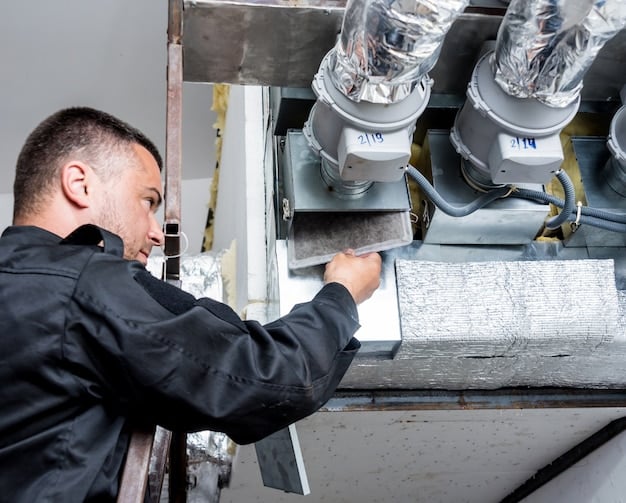HFC Phasedown Under the AIM Act: Impact on the HVAC Industry

The AIM Act’s phasedown of Hydrofluorocarbons (HFCs) is significantly reshaping the HVAC industry, pushing manufacturers toward more eco-friendly refrigerants, enhancing energy efficiency, and spurring innovation in cooling technologies while ensuring compliance with evolving environmental standards.
The How Will the Phasedown of Hydrofluorocarbons (HFCs) Under the AIM Act Impact the HVAC Industry? is a question that has significant implications for manufacturers, contractors, and consumers alike. This article explores the key changes, challenges, and opportunities arising from this critical environmental policy.
Understanding the American Innovation and Manufacturing (AIM) Act
The American Innovation and Manufacturing (AIM) Act is a U.S. law enacted in 2020 that aims to phase down the production and consumption of hydrofluorocarbons (HFCs). HFCs are potent greenhouse gases commonly used in refrigeration and air conditioning. This legislation is a critical component of the global effort to combat climate change.
Key Provisions of the AIM Act
The AIM Act grants the Environmental Protection Agency (EPA) the authority to regulate HFCs. The Act sets a schedule for reducing HFC production and consumption over the next 15 years. Here are the critical aspects:
- Phasedown Schedule: The AIM Act mandates a gradual reduction in HFC production and consumption, starting with a 10% reduction in 2022 and reaching an 85% reduction by 2036.
- Sector-Based Restrictions: The EPA can set specific restrictions on HFC use in various sectors, including the HVAC industry.
- Technology Transitions: The Act promotes the transition to alternative refrigerants with lower global warming potential (GWP).
Compliance with the AIM Act is not just a regulatory requirement; it’s an opportunity for the HVAC industry to innovate and lead in sustainable practices. This shift requires a proactive approach to adopting new technologies and refrigerants.

The Impact on HVAC Manufacturers
The AIM Act’s phasedown of HFCs has profound implications for HVAC manufacturers. These companies must adapt their product lines to comply with the new regulations, impacting research and development, production processes, and supply chains.
Research and Development
Manufacturers are investing heavily in R&D to identify and implement alternative refrigerants that have lower global warming potential (GWP) and maintain or improve energy efficiency. This involves:
- Testing New Refrigerants: Rigorous testing of alternatives like R-32, R-454B, and CO2 to ensure they meet safety and performance standards.
- Redesigning Equipment: Modifying HVAC systems to be compatible with these new refrigerants, as they often require different operating pressures and materials.
- Improving Energy Efficiency: Developing more energy-efficient systems to offset any potential performance trade-offs with the new refrigerants.
Companies that proactively invest in R&D will be better positioned to meet the AIM Act’s requirements and gain a competitive edge in the market. This includes partnerships with research institutions and suppliers to accelerate innovation.
Production and Supply Chain Challenges
The transition to new refrigerants also presents significant challenges for production and supply chains:
- Refrigerant Availability: Ensuring a stable and reliable supply of alternative refrigerants as HFC production decreases.
- Equipment Upgrades: Investing in new manufacturing equipment to handle the different properties of alternative refrigerants.
- Training and Certification: Providing training for technicians on how to handle and service equipment using these new refrigerants.
Manufacturers are working closely with refrigerant suppliers and industry associations to address these challenges and ensure a smooth transition. This includes diversifying supply sources and investing in workforce development programs.
The Role of HVAC Contractors
HVAC contractors play a critical role in implementing the AIM Act’s objectives. They are responsible for installing, maintaining, and servicing HVAC systems in residential and commercial buildings. Adapting to the changing landscape of refrigerants and technologies is essential for their continued success.

Training and Certification
With the introduction of new refrigerants, proper training and certification are more important than ever. Contractors need to ensure their technicians are well-versed in the safe handling, installation, and maintenance of systems using alternative refrigerants. Key areas of training include:
- Refrigerant Handling: Learning the specific procedures for handling new refrigerants to minimize leaks and prevent environmental damage.
- System Installation: Understanding the specific requirements for installing equipment with alternative refrigerants, including pressure settings and compatibility issues.
- Troubleshooting and Repair: Developing the skills to diagnose and repair systems using new refrigerants effectively.
HVAC contractors should seek certifications from reputable organizations and participate in ongoing training to stay up-to-date with the latest industry standards and best practices. This commitment to training will enhance their reputation and ensure they can provide high-quality service.
Adopting New Technologies
Staying competitive in the HVAC industry requires contractors to embrace new technologies and offer their customers the latest energy-efficient solutions. This includes:
- Variable Refrigerant Flow (VRF) Systems: Installing and servicing VRF systems that use alternative refrigerants and offer precise temperature control.
- Heat Pumps: Promoting heat pumps as an energy-efficient alternative to traditional heating and cooling systems.
- Smart HVAC Systems: Integrating smart thermostats and other technologies to optimize energy consumption and improve system performance.
By offering these advanced technologies, HVAC contractors can help their customers reduce their carbon footprint, lower their energy bills, and comply with environmental regulations.
Consumer Impact and Benefits
The AIM Act has several direct and indirect benefits for consumers. While the initial transition may involve some upfront costs, the long-term advantages of energy efficiency and environmental protection are significant.
Energy Efficiency and Cost Savings
One of the primary benefits of the AIM Act is the promotion of more energy-efficient HVAC systems. Alternative refrigerants often enable equipment to operate more efficiently, leading to lower energy consumption and reduced utility bills. This is particularly true for:
- High-Efficiency Air Conditioners: New air conditioners designed with lower GWP refrigerants can achieve higher SEER (Seasonal Energy Efficiency Ratio) ratings.
- Advanced Heat Pumps: Modern heat pumps offer improved heating and cooling performance, reducing reliance on fossil fuels and lowering energy costs.
Consumers who invest in these energy-efficient systems can save money on their energy bills over the lifespan of the equipment, offsetting any initial cost increases.
Environmental Benefits
The phasedown of HFCs under the AIM Act has significant environmental benefits, including:
- Reduced Greenhouse Gas Emissions: Lowering the amount of HFCs released into the atmosphere helps mitigate climate change and reduces the overall greenhouse gas effect.
- Improved Air Quality: Transitioning to cleaner refrigerants reduces the potential for harmful emissions that can degrade air quality.
By supporting the AIM Act, consumers contribute to a healthier environment and a more sustainable future. They also help ensure that future generations can enjoy a planet free from the worst effects of climate change.
Navigating Regulatory Compliance
Compliance with the AIM Act is essential for all stakeholders in the HVAC industry. Both manufacturers and contractors must understand and adhere to the EPA’s regulations to avoid penalties and ensure they are operating legally. Staying informed and proactive is key to navigating this regulatory landscape.
EPA Regulations and Enforcement
The EPA is responsible for implementing and enforcing the AIM Act. This includes:
- Setting HFC Reduction Targets: Establishing annual targets for reducing HFC production and consumption.
- Issuing Allowances: Allocating allowances to manufacturers and importers for the production and import of HFCs.
- Conducting Inspections: Performing inspections to ensure companies are complying with the regulations.
Companies that fail to comply with the AIM Act may face significant fines and other penalties. It is crucial to maintain accurate records and implement robust compliance programs.
Staying Informed
The regulatory landscape surrounding HFCs and the AIM Act is constantly evolving. To stay informed, stakeholders should:
- Monitor EPA Updates: Regularly check the EPA’s website for updates on regulations and guidance documents.
- Join Industry Associations: Participate in industry associations that provide valuable information and resources on compliance.
- Attend Webinars and Conferences: Attend industry events to learn about the latest developments and best practices.
Proactive engagement and continuous learning are essential for ensuring compliance and staying ahead of the curve in the HVAC industry.
Future Trends and Innovations
The AIM Act is not only driving current changes but also shaping the future of the HVAC industry. As technology advances and environmental concerns grow, expect to see continued innovation and a greater emphasis on sustainable solutions.
Emerging Refrigerants and Technologies
Several emerging refrigerants and technologies are poised to transform the HVAC industry in the coming years. These include:
- Hydrocarbons (HCs): Natural refrigerants like propane and isobutane offer excellent energy efficiency and minimal environmental impact.
- Ammonia (NH3): Ammonia is a highly efficient refrigerant with zero GWP, making it suitable for industrial applications.
- Advanced Compression Technologies: Innovations in compressor design, such as magnetic levitation compressors, can further enhance energy efficiency.
These technologies offer the potential for even greater energy savings and environmental benefits, paving the way for a more sustainable HVAC industry.
The Expanding Role of Green Building Practices
The focus on sustainable HVAC solutions aligns with the broader trend of green building practices. As more building owners and developers prioritize energy efficiency and environmental responsibility, the demand for sustainable HVAC systems will continue to grow. This includes:
- LEED Certification: Pursuing LEED (Leadership in Energy and Environmental Design) certification for buildings, which recognizes and rewards sustainable design and construction practices.
- Net-Zero Buildings: Designing buildings that generate as much energy as they consume, reducing their overall carbon footprint.
By embracing green building practices and adopting sustainable HVAC solutions, the industry can contribute to a more environmentally friendly and resilient built environment.
| Key Point | Brief Description |
|---|---|
| 🌱 AIM Act | Phases down HFCs by 85% by 2036, promoting eco-friendly refrigerants. |
| ⚙️ Manufacturers | Investing in R&D for alternative refrigerants and redesigning equipment. |
| 🛠️ Contractors | Require training and certification for new refrigerant handling. |
| 💰 Consumers | Benefit from energy-efficient systems and reduced utility bills. |
Frequently Asked Questions (FAQs)
▼
The AIM Act is a U.S. law designed to phase down the production and consumption of hydrofluorocarbons (HFCs), potent greenhouse gases used in refrigeration and air conditioning, aiming for an 85% reduction by 2036.
▼
HVAC manufacturers must invest in research and development to create systems that use alternative refrigerants with lower global warming potential and redesign equipment to accommodate these new substances.
▼
HVAC contractors are responsible for installing, maintaining, and servicing systems using new refrigerants. They need proper training and certification to handle these substances safely and efficiently.
▼
Consumers benefit from more energy-efficient HVAC systems, which lead to lower energy bills and reduced greenhouse gas emissions, contributing to a healthier environment and sustainable future.
▼
The HVAC industry can ensure compliance by staying informed about EPA regulations, investing in training, participating in industry associations, and adopting new technologies and best practices for refrigerant management.
Conclusion
The How Will the Phasedown of Hydrofluorocarbons (HFCs) Under the AIM Act Impact the HVAC Industry? is a transformative shift that demands proactive adaptation and innovation. By embracing new technologies, prioritizing training, and adhering to regulatory guidelines, the HVAC industry can navigate the challenges and capitalize on the opportunities presented by this landmark legislation, ultimately contributing to a more sustainable and energy-efficient future.





